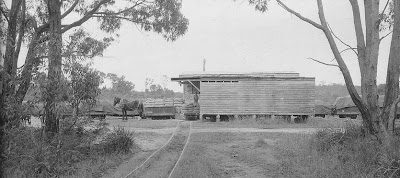Hi all,
Thought it was time for an update of some projects. I've mainly been spending some time on my "bush in a box" diorama, that was started some time ago, but like many other projects, had some distractions along the way. The influence for this type of project comes from fellow scenery master, Geoff Nott (of Red Stag and Muskrat Ramble efforts), who many of you will be familiar with Geoffs modelling pieces. Geoff has created a number of boxed diorama's featuring his talents for very dense scenery. Generally, his diorama's feature the trees cut off by the top of the box, creating a cropped view into the bush setting. After I began making my taller gum trees and Mountain Ash pieces, I wanted a way to show of their size (cutting them off to fit in a box didn't seeem to do them justice) and get them into a nice scene for taking to exhibitions to display, so have taken the bush box concept, and basically added a heap more height...
This box I have been working on, likely to be called "Splitters Gorge", stands around 1000mm tall, 700mm across, and just 500mm deep. The added height made the back scene a bit more of a challenge, as there was a full height of scenery to try and cover. I toyed with a photo backdrop, but covering that full scene wasn't working, so I opted to paint one in oils. The effect I was after was the slightly blurred distant scenery, and not too detailed to draw away from the main foreground scenery. Once the trees start going in front of the painted backdrop, I think its fairly effective...
 This type of scenery chews up heaps of trees. This small ridge along the top of the diorama is only about 150mm deep (6"), and has already taken up about two dozen of the gum trees (not to mention all the other filler bush foliage and smaller trees, grass, ferns etc). Most of what is scene here will be faily obscured once the foreground scenery goes in, but the background wiil be visible to those that look hard enough into the scene. Its all about the depth and density.
This type of scenery chews up heaps of trees. This small ridge along the top of the diorama is only about 150mm deep (6"), and has already taken up about two dozen of the gum trees (not to mention all the other filler bush foliage and smaller trees, grass, ferns etc). Most of what is scene here will be faily obscured once the foreground scenery goes in, but the background wiil be visible to those that look hard enough into the scene. Its all about the depth and density.Here's a bit of a reference image for the type of moss covering I'm heading towards, taken on one of the family bushwalks in Lorne, Victoria. Its not a heavy moss, but more of a thin film that just gathers within the dampness from the waterfall.
Finally, a quick shot of the small bush hut that will be part of the diorama, sitting at the base of the gorge. I wanted to place a man made structure into the scene to help with setting the scale and perspective of the surrounds. Its made from basswood over a matte board shell. Once in the scene, there will also be a few surrounding details to indicate the workings of bush living.
Thats about where it is at the present. Hopefully some time off work around Christmas will allow some time to work on a few more trees for the scene. I am hoping to have this one finished in time for the "Southern Forests" meeting for fellow narrow gauge enthusiast, down in Puffing Billy country next March.
Cheers,
Dan
















































